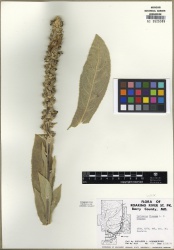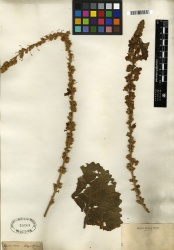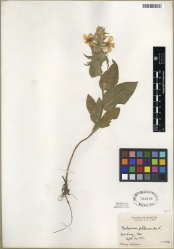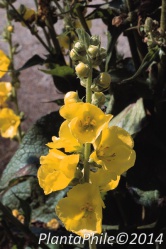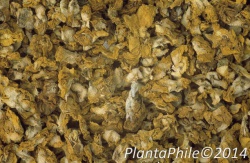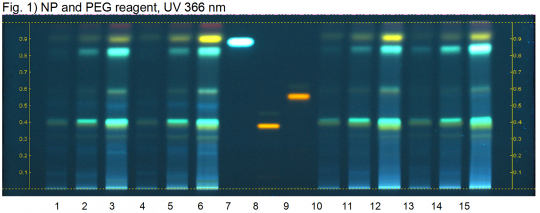Verbascum spp. (flower)
Contents |
Nomenclature
Botanical Voucher Specimen
|
|
|
|
Organoleptic Characteristics
|
Macroscopic Characteristics
|
Microscopic Characteristics
High Performance Thin Layer Chromatographic Identification
|
Mullein (flower) (Verbascum thapsus L., V. densiflorum Bertol. syn. V. thapsiforme Schrad, V. phlomoides L.) Lane Assignments Lanes, from left to right (Track, Volume, Sample):
Reference Sample(s) Reference: Dissolve 3.5 mg of rutin in 5 mL of methanol; Dissolve 2 mg of caffeic acid in 5 mL of methanol; Optional: 4 mg of hyperoside in 5 mL of methanol. Stationary Phase Stationary phase, i.e. Silica gel 60, F254 Mobile Phase Ethyl acetate, formic acid, water, ethyl methyl ketone 50:10:10:30 (v/v/v/v) Sample Preparation Method Sample: Mix 1 g of powdered sample with 10 mL of methanol and sonicate at 60°C for 10 minutes, then centrifuge or filter the solutions and use the supernatants / filtrates as test solutions. Derivatization reagent: 1.) NP reagent, Preparation: 1 g of NP reagent in 200 mL ethyl acetate; 2.) PEG reagent, Preparation: 10g of polyethylene glycol 400 in 200 mL of dichloromethane, Use: Heat plate for 3 min at 100°C, then dip (time 0, speed 5) in NP reagent, dry and dip (time 0, speed 5) in PEG reagent. Detection Method Saturated chamber; developing distance 70 mm from lower edge; relative humidity 33% Other Notes Images presented in this entry are examples and are not intended to be used as basis for setting specifications for quality control purposes. System suitability test: Rutin: orange fluorescent zone at Rf ~ 0.38; Caffeic acid: blue fluorescent zone at Rf ~ 0.89. Identification: Compare result with reference images in Image Comparison Viewer. The fingerprint of the test solution is similar to that of the corresponding botanical reference sample. Additional weak zones may be present. The chromatogram of the test solution shows an intense bluish zone at Rf ~ 0.40 just above the position of reference substance rutin. There is another bluish zone at Rf ~ 0.60 slightly higher than the position of reference substance hyperoside. Just below the position of reference substance caffeic acid there is an intense bluish zone at Rf ~ 0.82 and just above caffeic acid there is a yellow zone at Rf ~ 0.90.
|
Supplementary Information
Sources
- ↑ MOBOT, Tropicos.org http://www.tropicos.org/Image/100123204
- ↑ MOBOT, Tropicos.org http://www.tropicos.org/Image/100279961
- ↑ MOBOT, Tropicos.org http://www.tropicos.org/Image/100123203
- ↑ United States Dispensatory (1918)
- ↑ American Medicinal Plants of Commercial Importance (1930)
- ↑ United States Dispensatory (1918)
- ↑ PlantaPhile http://plantaphile.com/
- ↑ PlantaPhile http://plantaphile.com/
- ↑ HPTLC Association http://www.hptlc-association.org/
